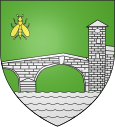Le Pont-de-Montvert
| Le Pont-de-Montvert | ||
|---|---|---|

|
|
|
| local community | Pont de Montvert - Sud Mont Lozère | |
| region | Occitania | |
| Department | Lozère | |
| Arrondissement | Florac | |
| Coordinates | 44 ° 22 ′ N , 3 ° 45 ′ E | |
| Post Code | 48220 | |
| Former INSEE code | 48116 | |
| Incorporation | January 1, 2016 | |
| status | Commune déléguée | |
 Le Pont-de-Montvert - town center and bridge over the Tarn river |
||
Le Pont-de-Montvert is a village and a commune déléguée in the French commune of Pont de Montvert - Sud Mont Lozère with 327 inhabitants (as of January 1, 2017) in the Lozère department in the Occitania region (previously Languedoc-Roussillon ).
location
Le Pont-de-Montvert is about 880 m above sea level. d. M. at the confluence of two streams ( Le Martinet and Le Rieumal ) in the upper reaches of the Tarn ; the place is part of the Cevennes National Park , part of the Massif Central . The Mont Lozère is located nearby . The closest city is Florac, about 20 km to the west .
Population development
| year | 1800 | 1851 | 1901 | 1954 | 1999 | 2013 |
| Residents | 1,255 | 1,445 | 1,126 | 509 | 272 | 292 |
Because of the remote location of the place and the increasing mechanization of agriculture , the population fell continuously in the first half of the 20th century.
economy
For centuries, the inhabitants of the community lived mostly as self-sufficient farmers from agriculture, which also included cattle breeding (sheep, goats, cattle, chickens). As a regional economic center, the place was also attractive for small trade, crafts and other smaller service companies. In the meantime, tourism plays an important role in the form of the rental of holiday apartments ( gîtes ); Canoe tours on the Tarn are also possible.
history
In the course of the Albigensian Crusade (1209-1229), the lord of the castle fled to the county of Toulouse with his men and some Jews who had been given shelter . The castle was destroyed by the troops of Simon de Montfort . In the religious conflicts of the 16th and 17th centuries, most of the town's residents sided with the Protestants . After the murder of the Abbé du Chayla in 1702, the Camisard Wars began in the Cevennes.
With effect from January 1, 2016, it was merged with the communes of Fraissinet-de-Lozère and Saint-Maurice-de-Ventalon to form the Commune nouvelle Pont de Montvert - Sud Mont Lozère and has since had the status of a Commune déléguée .
Attractions
- The two-arched bridge ( pont ) over the Tarn , dating from the 17th century in its current state, is the town's landmark. It has a three-storey bridge tower at the side for control purposes and to collect the bridge toll . The building has been recognized as a monument historique since 1950 .
- The place has a Catholic and a Protestant church ( temple ).
- A small museum deals with the history as well as the fauna and flora of the Cevennes National Park .
- outside
- The Château de Grisac ( 44 ° 20 ′ 30 ″ N , 3 ° 41 ′ 51 ″ E ), which already existed in the 13th century but was expanded in the 14th century by Guillaume de Grimoard, later Pope Urban V , stands on a hill in the hamlet of Grizac about 2 km southwest of Le Pont-de-Montvert. The castle and its outbuildings were expanded again and again until the 17th century; the privately owned complex has been recognized as a Monument historique since 1984 .
Personalities
- 1309: The future Pope Urban V (1362-1370) was born at the Château Grisac , which belongs to the municipality .
- 1702: Abbé du Chayla , an almost inquisitorial supporter of the Royal Catholic Party, was murdered in his home in Le Pont-de-Montvert.
- 1878: The Scottish writer Robert Louis Stevenson stopped in Le Pont-de-Montvert on his famous hike through the Cevennes.
Web links
Individual evidence
- ↑ Pont de Montvert in the Base Mérimée of the French Ministry of Culture (French)
- ↑ Château de Grisac in the Base Mérimée of the French Ministry of Culture (French)

